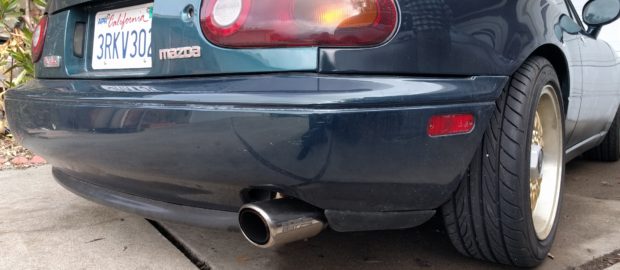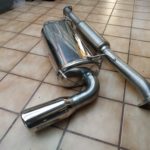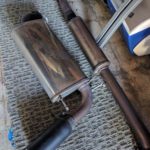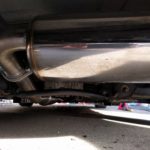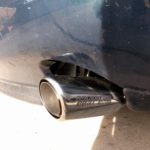Four cylinder exhausts seem to be hit or miss. Designing them to sound properly sporty can be a tall order. Get it wrong though, and there’s a solid chance you’ll receive a casting call for the next Fast and the Furious movie. Our Miata project car definitely falls into the latter category, and has been waking the neighbors every morning for the past few months. It’s probably time we make it a little less of a mobile protest against “The Man.”
Dialed Back From 11
Obviously we didn’t want to completely mute the exhaust of the famed roadster, but the Jackson Racing exhaust that came equipped on the car was just asking to get us pulled over should we cross paths with a disgruntled officer of the law. After some reading and a few phone calls, Good-Win Racing assured us that the Racing Beat Power Pulse exhaust system would be the solution to our problem. For the NA Miata, most aftermarket exhaust systems come in two parts. There’s the connecting pipe from the cat, and then there’s the muffler itself. The mufflers will fit any variant of the NA Miata (1.6 or 1.8), but the connecting pipe has a few variations. We chose the option for the standard connecting pipe made for a 1996-1997 car. This translates to a pipe with a post cat oxygen sensor port, and a built in resonator to ensure the noise level doesn’t get out of hand (If we end up wanting more noise later, we can always swap it out with Racing Beat’s non-resonated version). This was not one of the cheaper purchases we’ve made for the Miata ($280 for the muffler, and $140 for the connecting pipe), but we plan to recuperate some of the cost by selling the old JR exhaust setup.
- Fresh out of the box: The Racing Beat Power Pulse exhaust system.
- This is the old Jackson racing/Moss Miata setup that was originally on the car. With some metal polish it cleaned up pretty good, but it was way too loud for daily driving.
You might think that we’re going to make the Miata too quiet to the point it’s no longer sounds sporty. Fear not, for we thought ahead. Since this particular Miata has the M45 supercharger installed, the exhaust velocity is going to be faster (and therefore louder) than a car without forced induction.
Installed and Done for the Evening
The first order of business was to get the rear end up on jack stands. Since the Miata lived in the fog of San Francisco under its previous ownership, the nuts and bolts connecting the exhaust were very corroded. A soak in Liquid Wrench was in order to prevent shearing anything. While it may not be specific to every Miata, we did notice a rear cross brace in the way of the muffler piping. It’s only attached by two 17mm bolts, but it’s worth mentioning for other people who may have the brace installed on their Miatas.
To remove the muffler, a 14mm wrench and matching socket are used to undo the two flange bolts. Slide the muffler off the rubber hangers, and it’s off the car. The midsection is removed using a similar process, but OBD2 cars have an extra step. Since there’s an oxygen sensor on the 1996 & 1997 cars, you’ll need to swap it over to the new midpipe. For the time being it’s easier to keep it on the pipe during removal, but you don’t want to damage the wiring. To disconnect the sensor, fold the driver’s seat forward and lift up the rear carpeting. There’s an opening that comes out of the transmission tunnel with a connector. Unplug the connector and you can snake the sensor wiring out of the car. If you really want to make the neighbors upset, this is a great opportunity to start the car.
The Grown-Up Choice
The new Racing Beat exhaust system impressed both Milton and I once it arrived in the mail. The packaging was very thorough, and the welds appear to be very high quality. New hardware and gaskets were also included with our purchase, so we didn’t have to worry about crusty bolts being and eyesore on the shiny new exhaust. As mentioned earlier, we had to swap over the oxygen sensor from the old exhaust. The sensor on our midpipe was acting extra stubborn, so it required a good stomp of the 22mm wrench to finally get it to budge.
Reassembly is fairly intuitive. We slipped the muffler section onto the existing exhaust hangers (a little dish soap makes this extra easy), then loosely placed the midsection into position with the supplied hardware. Feed the sensor back into the interior cabin and everything can be tightened up before putting the car back on the ground.
The first start was met with both surprise and sadness. The car is noticeably quieter, if only slightly louder than stock at idle. This was good in the sense that the car draws less attention upon startup, but there’s a lack of a sporty tone that most enthusiasts enjoy with a cold startup. Around town cruising is mellow and doesn’t bring any unwanted attention to the ambiguously colored two-seater. Mashing the accelerator though creates a sporty exhaust note, but not until the upper echelons of the rev range.
One improvement we appreciated for daily driving was the lack of interior droning on the freeways, especially with an engine that spins 4,000 rpm at 80 mph. As for power, the butt dyno can’t discern any noticeable increases or losses, but an exhaust upgrade on a small displacement engine isn’t going to see big numbers to begin with. Maybe the more miles we put on the new exhaust will break things in, and hopefully give us a tad more volume.
- With 2.25″ diameter piping, this should be plenty for our supercharged 1.8 liter.
- Polished tip, with a reminder of it’s SoCal origins.
For a daily driver, this exhaust is a solid choice. Things are quiet inside the car, but a spectator will definitely still hear the car coming (especially helpful when surrounded by 5,000 lb SUVs that can’t always see the tiny Miata). To top things off, we were able to sell the old muffler and midpipe for $200, so that put a little cash back in the wallet.
As we make our way through the various projects on the Miata, we’ve been able to steadily turn a ratty car into a well rounded package with quality parts. Of course it helps that the “puffer” was on the car when we got it, but the remainder of the upgrades have all been reasonably priced in comparison to other cars we’ve tinkered with over the years. Maybe it is possible to make a car over twenty years old both a comfortable and reliable daily driver without breaking the bank. Just maybe.
-JC
Want a sporty exhaust without waking the neighborhood? Here are the parts we used:
Racing Beat Power Pulse Muffler
Racing Beat Standard Connecting Pipe
If you’re still on the fence, hear the exhaust for yourself:

